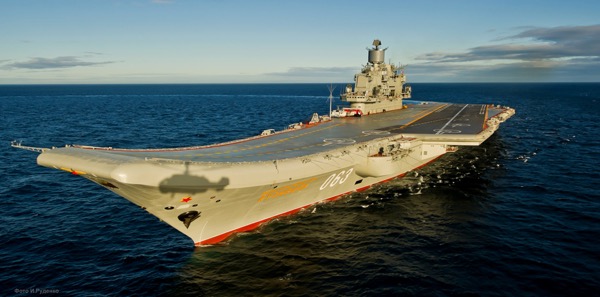 Twenty-six years after Russia’s only aircraft carrier entered service, she is reportedly heading into combat for the very first time—in Syria.
Twenty-six years after Russia’s only aircraft carrier entered service, she is reportedly heading into combat for the very first time—in Syria.
“The general staff has prepared a plan for involvement of the deck aircraft in delivering strikes on terrorist groups in the Syrian Arab Republic,” an unnamed “diplomatic source” told the state-owned news agency TASS. With the flattop Admiral Kuznetsov holding station in the Mediterranean Sea, “crews will practice taking off the carrier to deliver strikes on ground targets.”
The deployment is reportedly scheduled to begin in October and last up to four months.
Prepare to be underwhelmed. Kuznetsovis too small, too unreliable, and her 15 fighter jets too lacking in flying range, weapons, and sensors to make a meaningful contribution to Russia’s nine-month-old intervention in Syria.
Indeed, Russia’s very first carrier air strikes will be mostly for show—although, to be fair, they could also benefit the flattop’s long-suffering crew. The thousand-foot-long Kuznetsov is rusty, leaky, and prone to fuel spills and fatal accidents. She rarely sails from her home port in northern Russia and, as a consequence, her crew struggles to maintain seagoing proficiency.
“I think this is really just an opportunity for Russia to demonstrate the relevance of its relatively small and aging carrier aviation capabilities while also giving their crews the opportunity to practice and enhance their skills in a combat environment,” Eric Wertheim, an independent naval expert and the author of Combat Fleets of the World, told The Daily Beast via email. “I think they’re using the Syrian operations as an opportunity to do just that for many of their previously neglected naval forces.”
Although she’s the flagship of the Russian fleet, Kuznetsov is hardly Moscow’s most powerful warship—an honorific that probably belongs to one of the Russia’s new nuclear-powered submarines or missile-armed atomic cruisers.
The U.S. Navy—by far the world’s leading naval aviation power—operates 10 large, nuclear-powered Nimitz-class carriers and nine smaller, carrier-like amphibious assault ships, and can simultaneously deploy several of the vessels to combat zones, with each vessel remaining at sea for six months or more at a time.
This summer, the Americans sent two large carriers and an assault ship to strike ISIS militants in Iraq and Syria. Each big U.S. flattop sails with an air wing of 60 or more aircraft, including more than 40 F/A-18 fighters. A large American carrier can launch more than 100 air raids a day, with every fighter carrying multiple smart bombs, each of which can—in theory—strike a different target.
Russia has just the one carrier. Her deployments are less frequent and shorter than U.S. vessels’ are—and so are the missions her planes are capable of undertaking. “I bet they don’t put up 50 sorties in any 24-hour period,” Jerry Hendrix, a former U.S. Navy strategist who is now an analyst with the Center for a New American Security think tank in Washington, D.C., said of the Russians.
Kuznetsov’s fighters carry mostly unguided “dumb” bombs that lack the precision of their U.S. counterparts. Equally problematic, the Russian carrier doesn’t have the catapults that, on large U.S. carriers, help to boost planes into the air with heavy loads of fuel and weapons. As a consequence, the Russian ship’s Su-33 and MiG-29 fighters carry partial fuel loads and just a few weapons when they take off.
The Kremlin is clearly aware of Kuznetsov’s limitations—and reportedly has plans to partially mitigate them. The ship will remain close to the Syrian shore “so that the deck aircraft have enough fuel to complete the military tasks and return back,” the anonymous official told TASS.
Still, Kuznetsov and her 15 planes are unlikely to make much difference in Russia’s air war in Syria—not as long as Moscow’s land-based planes are so much more capable of sustaining intensive air operations. In October, the Kremlin deployed around three dozen warplanes to Khmeimim air base in Latakia, in western Syria. Boosted by long-range bombers flying directly from Russia, those planes have conducted thousands of air strikes targeting rebel forces and civilians in rebel-held areas.
“Kuznetsov has never performed a land strike role, and it doesn’t make any sense to use [her] that way, considering the availability of the Latakia air base,” Maxim Shepovalenko, a retired Russian navy captain who is now the deputy director of the Center for the Analysis of Strategies and Technologies in Moscow, told The Daily Beast. “Just compare the tonnage, stores, and air-wing strength of a Nimitz-class and those of Kuznetsov. No match.”
As pointless as the carrier deployment might be from a military standpoint, it actually makes a lot of economic sense. Naval shipbuilding is big business in Russia, but the country’s dilapidated shipyards have earned a reputation for producing crappy aircraft carriers and equally crappy carrier-launched planes.
Just ask the Indians, who ordered a refurbished flattop from a Russian yard back in 2004. The carrier Vikramaditya arrived years late and billions of dollars over-budget, and on her first voyage in 2013 suffered a devastating engine failure. India has been buying MiG-29 fighters to fly from Vikramaditya, and Russia is keen to extend that deal. If it appears successful, Kuznetsov’s Syria deployment could “lure” the Indians into buying more MiGs, Shepovalenko said.
Another customer of Russian carriers is likely to pay close attention to Kuznetsov’s war debut. In 2011, China commissioned into service an upgraded copy of Kuznetsov named Lioaning. She’s China’s first and so far only flattop. She’s never seen combat, either. And if Kuznetsov can pull off her inaugural wartime mission without major embarrassment, maybe Lioaning can, too.
The Daily Beast

Leave a Reply
You must be logged in to post a comment.